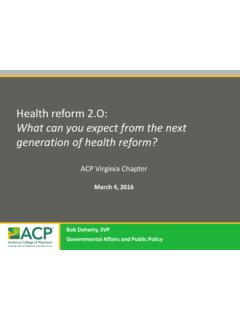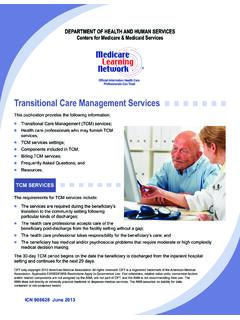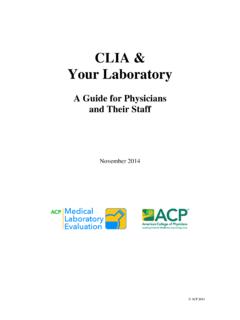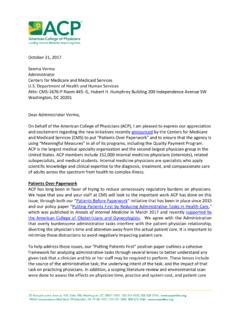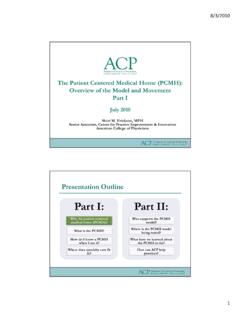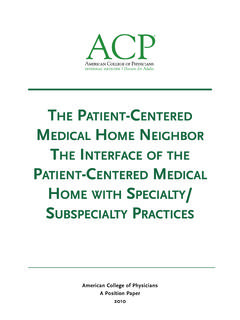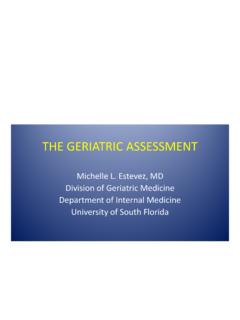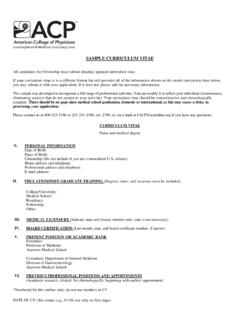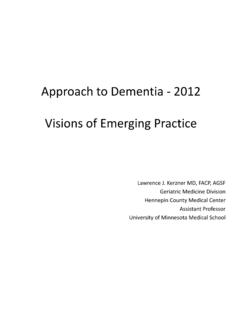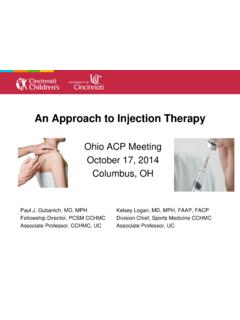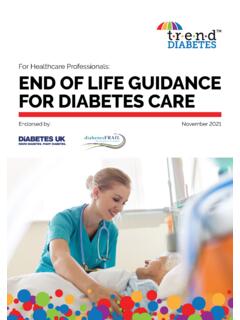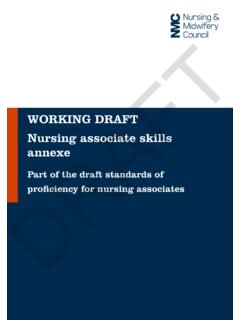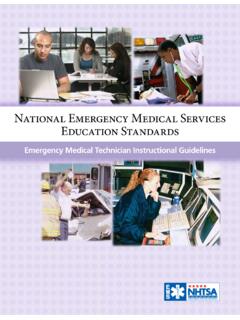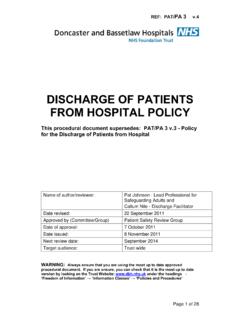Transcription of Physician-Assisted Suicide
1 Position Paper Physician-Assisted Suicide Lois Snyder, JD, and Daniel P. Sulmasy, OFM, MD, PhD, for the Ethics and Human Rights Committee, American College of Physicians American Society of Internal Medicine*. Medical professional codes have long prohibited physician in- The American College of Physicians American Society of volvement in assisting a patient's Suicide . However, despite ethi- Internal Medicine (ACP ASIM) does not support the legalization cal and legal prohibitions, calls for the liberalization of this ban of Physician-Assisted Suicide . The routine practice of physician- have grown in recent years. assisted Suicide raises serious ethical and other concerns. Legal- The medical profession should articulate its views on the ization would undermine the patient physician relationship and arguments for and against changes in public policy and decide the trust necessary to sustain it; alter the medical profession's role whether changes are prudent. In addressing such a contentious in society; and endanger the value our society places on life, issue, physicians, policymakers, and society must fully consider especially on the lives of disabled, incompetent, and vulnerable the needs of patients, the vulnerability of particular patient groups, individuals.
2 The ACP ASIM remains thoroughly committed to im- issues of trust and professionalism, and the complexities of end- proving care for patients at the end of life. of-life health care. Physician-Assisted Suicide is prominent among Ann Intern Med. 2001;135:209-216. the issues that define our professional norms and codes of ethics. For author affiliations and current addresses, see end of text. I s Physician-Assisted Suicide the answer? This may de- pend on the question. Is it an issue of patient rights? Of medicine's limitations? Of trust? Of fear and control sician-assisted death, which lump together categories, can obscure the ethics of what is at stake. Recent voter initiatives and court decisions have re- for patients? Is it a legal issue? An ethical or moral issue? flected public interest in Physician-Assisted Suicide . An individual issue? A societal issue? It is all of these. Many people fear a painful and protracted death or de- Many have theorized about the merits or dangers of sire more control over the dying process.
3 Some fears Physician-Assisted Suicide . But whether it should be le- have been justified. Our societal emphasis on cure and gally sanctioned is a question with no easy answers. the medical emphasis on intervention have sometimes Physician-Assisted Suicide is only one of many clin- been at the expense of good end-of-life care. We have ically and ethically distinguishable practices in end-of- been slow to embrace the practice and principles of hos- life care. Most commonly, life-sustaining treatments are pice, and dissemination of state-of-the-art palliative care, withheld or withdrawn when patients refuse such treat- especially pain control techniques, has been incomplete. ment. The ethical and legal consensus about such prac- Reimbursement disincentives for comfort care have ex- acerbated the problem, and cost-control pressures that tices is well established. Physician-Assisted Suicide , discourage expensive long-term care loom large over care however, is a different type of act, and is far more con- at the end of life.
4 Troversial. In Physician-Assisted Suicide , medical help is Most individuals who contemplate or succeed at provided to enable a patient to perform an act that is Suicide are depressed or have other psychiatric comorbid specifically intended to take his or her own life, for ex- conditions (2 6). Among terminally ill patients who de- ample, overdosing on pills as prescribed by the physician sire death, the wish fluctuates significantly over time (7, for that purpose. Physician-Assisted Suicide should be 8). Others are not receiving effective pain and symptom distinguished from euthanasia, in which the physician control, are not experiencing caring and compassion performs an act that is specifically intended to take the from their health care providers (or family or friends), or patient's life, through, for example, lethal injection (1). live in fear that they will not receive these when needed Our use of these terms throughout this paper is based on (9, 10). Some are concerned about finances or being a these definitions.
5 Terms such as aid-in- dying or phy- burden on their family. Some fear loss of control and *This paper was written by Lois Snyder, JD, and Daniel P. Sulmasy, OFM, MD, PhD, for the American College of Physicians American Society of Internal Medicine (ACP ASIM) Ethics and Human Rights Committee. Members of the Ethics and Human Rights Committee were Risa Lavizzo-Mourey, MD (Chair); David W. Potts, MD (Vice Chair); David A. Fleming, MD; Susan Dorr Goold, MD; Vincent E. Herrin, MD; Jay A. Jacobson, MD; Joanne Lynn, MD; Daniel P. Sulmasy, OFM, MD, PhD; William E. Golden, MD; and Lee J. Dunn Jr., JD, LLM. This paper was approved by the ACP ASIM Board of Regents on 27 October 2000. 2001 American College of Physicians American Society of Internal Medicine 209. Position Paper Physician-Assisted Suicide self-image or the prospect of being in a long-term care medicated (24 27). Some physicians withhold pain or other facility. Some are alone, or are vulnerable in medication because of largely ungrounded fears that ter- other ways.
6 Minally ill patients will become tolerant of or addicted The Institute of Medicine's report, Approaching to the medication or will abuse medications (24). When Death: Improving Care at the End of Life, found end- patients select palliation as their highest goal, physicians of-life care in the United States to be lacking in many should make relief of suffering the highest priority (23). ways (11), as did the $28 million Study to Understand Some physicians withhold palliative doses of opioids be- Prognoses and Preferences for Outcomes and Risks of cause they fear that the required higher doses may has- Treatment (12, 13). The cultural norm of medicine and ten death through respiratory suppression. Usually, ad- of hospital life is to fight hard to preserve life, and in equate pain relief does not hasten death (28). Even if life most cases this is the right thing to do. However, inap- may be shortened, there is strong support for increasing propriate aggressive care at the end of life can be emo- medications for terminally ill patients to levels that re- tionally, physically, and financially detrimental to pa- lieve pain (23, 29, 30).
7 Tients, their families, and health care providers. THE QUESTION OF Physician-Assisted Suicide . CLINICAL DUTIES: REACHING CONSENSUS ON For years, the consensus has been that, after a care- PALLIATIVE CARE ful weighing of patient autonomy, medical beneficence, Traditionally, the decision to forgo life-sustaining and societal interests, a patient may forgo life-sustaining treatment has been ethically, legally, and clinically dis- treatment. Some now argue that Physician-Assisted sui- tinguished from a request for physician assistance with cide is the logical next step. Suicide or euthanasia (14 16). Although the Hippo- Suicide and attempted Suicide have been decrimi- cratic Oath proscribes euthanasia and assisted Suicide nalized in the United States. They are now subjects of (17), abating treatment has been considered appropriate mental health law, not criminal law. Society does, how- when patients are overmastered by disease (18). Some ever, seek to prevent Suicide by allowing others to inter- lower-court decisions have questioned the importance of vene to prevent acts of self-destruction and involuntary this distinction (19), but the Supreme Court has hospitalization and by criminalizing the aiding of a consistently distinguished the refusal of treatment from Suicide .
8 Suicide (20, 21). The withdrawal of treatment based on Our society and the medical profession are divided patient wishes respects a patient's right to be free of on the issue of legalizing Physician-Assisted Suicide and unwanted medical treatment, while Physician-Assisted euthanasia for patients at the end of life. In the past, the Suicide and euthanasia invoke a right to have the physi- ACP ASIM and others have questioned whether a blan- cian provide a new intervention for the patient (22). ket condemnation of Physician-Assisted Suicide , with no The American College of Physicians American Society other comment, misses an opportunity to improve the of Internal Medicine (ACP ASIM) continues to believe care of dying patients (23, 31 34). Polls show signifi- that this distinction is important (23). cant public support (35, 36), and many physicians, Patients have a firmly established legal right to while reluctant to perform assisted Suicide or euthanasia refuse unwanted medical treatment.
9 Physicians should themselves, support the legalization of assisted Suicide not refrain from withholding or withdrawing medical (37 42). Nonetheless, assisting a Suicide remains a spe- interventions according to now well-established ethical cific statutory offense in most states (2). Euthanasia is and clinical standards. Patients might otherwise feel illegal everywhere in the United States. pressured to refuse a trial of life-sustaining treatment, or One state Oregon has legalized Physician-Assisted even to request assisted Suicide or active euthanasia, in Suicide (43 45). In other states, recent referenda and order to avoid what they fear might become prolonged bills to legalize assisted Suicide have been defeated (46 . use of life support. 49), and 15 states newly criminalized it between 1986. Patients often fear the prospect of unrelieved pain. and 1999 (50, 51). Other countries have experimented Many patients with terminal illness are, in fact, under- with Physician-Assisted Suicide and euthanasia.
10 In the 210 7 August 2001 Annals of Internal Medicine Volume 135 Number 3 Physician-Assisted Suicide Position Paper Netherlands, both practices had been illegal but toler- lower-court decisions persuasive. Instead, the Supreme ated under detailed guidelines. Recently, these practices Court specifically distinguished refusal of treatment were legalized (52). Euthanasia was briefly legalized, from Physician-Assisted Suicide . Refusal of treatment, from July 1996 to March 1997, in the Northern Terri- the Court concluded, is about being free of the bodily tory of Australia (53). invasion of unwanted medical treatment, not a right to something. This can be seen as a negative right a THE SUPREME COURT DECISIONS ON form of right of which Americans have many and ASSISTED Suicide differs from a positive right to secure assistance to kill In landmark decisions in July 1997, the Su- oneself and control the manner and timing of death preme Court ruled that there is no constitutional right (56).
